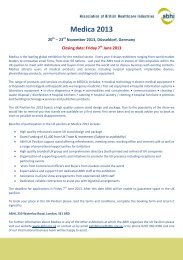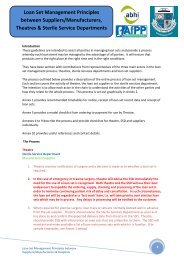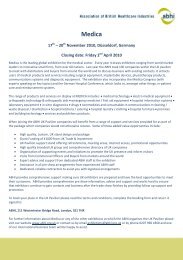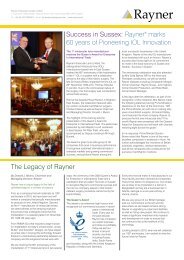hospital & healthcare equipment market in spain - Association of ...
hospital & healthcare equipment market in spain - Association of ...
hospital & healthcare equipment market in spain - Association of ...
You also want an ePaper? Increase the reach of your titles
YUMPU automatically turns print PDFs into web optimized ePapers that Google loves.
their Spanish subsidiary, SANITAS<br />
www.sanitas.es which, <strong>in</strong> 2009, stated they had<br />
40 <strong>hospital</strong>s. Some other lead<strong>in</strong>g companies<br />
<strong>in</strong>clude Adeslas, ASISA, Mafre Caja Salud, DKV.<br />
These health <strong>in</strong>surance firms either adm<strong>in</strong>ister<br />
their own cl<strong>in</strong>ics or determ<strong>in</strong>e the level <strong>of</strong> fees to<br />
be paid to doctors on their panel or <strong>hospital</strong>s<br />
under their schemes.<br />
60 per cent <strong>of</strong> the bus<strong>in</strong>ess <strong>of</strong> “private” <strong>hospital</strong>s<br />
or cl<strong>in</strong>ics comes via the contractual<br />
arrangements the health <strong>in</strong>surance firms have<br />
with these <strong>hospital</strong>s. The rema<strong>in</strong><strong>in</strong>g 40 per cent <strong>of</strong><br />
the <strong>in</strong>come <strong>of</strong> these private <strong>hospital</strong>s comes from<br />
the agreements they have with the Public Health<br />
Service, they use private <strong>hospital</strong> services to<br />
perform surgical processes <strong>in</strong> order to reduce the<br />
public sector wait<strong>in</strong>g lists <strong>of</strong> patients. The length<br />
<strong>of</strong> public sector wait<strong>in</strong>g lists causes concern and<br />
criticism from the public and politicians. It is<br />
<strong>in</strong>terest<strong>in</strong>g to note that subscribers to private<br />
health <strong>in</strong>surance schemes will, more <strong>of</strong>ten than<br />
not, turn to the Public Health Sector for major<br />
operations or treatment. The number <strong>of</strong> Spanish<br />
people prepared to pay for purely private health<br />
treatment is m<strong>in</strong>imal.<br />
Hospital beds<br />
Accord<strong>in</strong>g to the Spanish M<strong>in</strong>istry <strong>of</strong> Health &<br />
Social Policy, as <strong>of</strong> 31 December 2008 there were<br />
804 <strong>hospital</strong>s <strong>in</strong> Spa<strong>in</strong> with 160,983 beds. Tables<br />
giv<strong>in</strong>g statistics <strong>of</strong> <strong>hospital</strong>s and beds by region,<br />
general or specialist centres, public or private,<br />
the high tech <strong>equipment</strong> available, can be seen<br />
on the follow<strong>in</strong>g section <strong>of</strong> the M<strong>in</strong>istry’s web<br />
page under “Catálogo de Hospitales”.<br />
http://www.msc.es/ciudadanos/prestaciones/centrosServici<br />
osSNS/<strong>hospital</strong>es/<strong>in</strong>forEstadistica/home.htm<br />
In summary, 47 per cent <strong>of</strong> the <strong>hospital</strong>s have<br />
between 100 and 500 beds and 9.5 per cent have<br />
over 500 beds. Although on average 70 per cent <strong>of</strong><br />
the <strong>hospital</strong>s are <strong>in</strong> the public sector and 30 per<br />
cent <strong>in</strong> the private sector, this split can vary<br />
accord<strong>in</strong>g to regions. The percentage <strong>of</strong> private<br />
beds is reported to be higher than that figure <strong>in</strong><br />
Catalonia and lower <strong>in</strong> regions as such as<br />
Andalucia and Extremadura. Even though the ratio<br />
<strong>of</strong> <strong>hospital</strong> beds per population is lower than the<br />
EU average, the actual number <strong>of</strong> <strong>hospital</strong> beds<br />
has reduced <strong>in</strong> recent years as the emphasis is<br />
placed on day surgery <strong>in</strong> public health care<br />
centres and out patient sections <strong>of</strong> <strong>hospital</strong>s.<br />
Nurs<strong>in</strong>g homes<br />
Historically, <strong>in</strong> Lat<strong>in</strong> countries such as Spa<strong>in</strong>,<br />
elderly parents are looked after by the family. This<br />
tradition still exists but is chang<strong>in</strong>g slowly as can<br />
be seen by the <strong>in</strong>creased demand for beds <strong>in</strong><br />
nurs<strong>in</strong>g homes <strong>of</strong>fer<strong>in</strong>g assisted care. The latest<br />
figures published <strong>in</strong> January 2007 by IMSERSO,<br />
the Spanish Institute <strong>of</strong> Social Services for the<br />
Elderly, <strong>in</strong>dicate that for the total population <strong>of</strong> 7.5<br />
million aged over 65, there were 4,839 nurs<strong>in</strong>g<br />
homes. Only 35 per cent <strong>of</strong> these were <strong>in</strong> the<br />
public sector (either public or contracted from<br />
the private nurs<strong>in</strong>g home sector). The total<br />
number <strong>of</strong> 298,870 beds is low by EU standards.<br />
The ratio <strong>of</strong> beds per 100 people aged over 65 is<br />
about 4 per cent. Reports <strong>in</strong>dicate that well over<br />
90,000 elderly people are on the wait<strong>in</strong>g list for a<br />
bed <strong>in</strong> a public sector nurs<strong>in</strong>g home and for that<br />
reason, long term care elderly patients <strong>of</strong>ten<br />
occupy beds <strong>in</strong> public <strong>hospital</strong>s.<br />
SPANISH HEALTHCARE<br />
6













